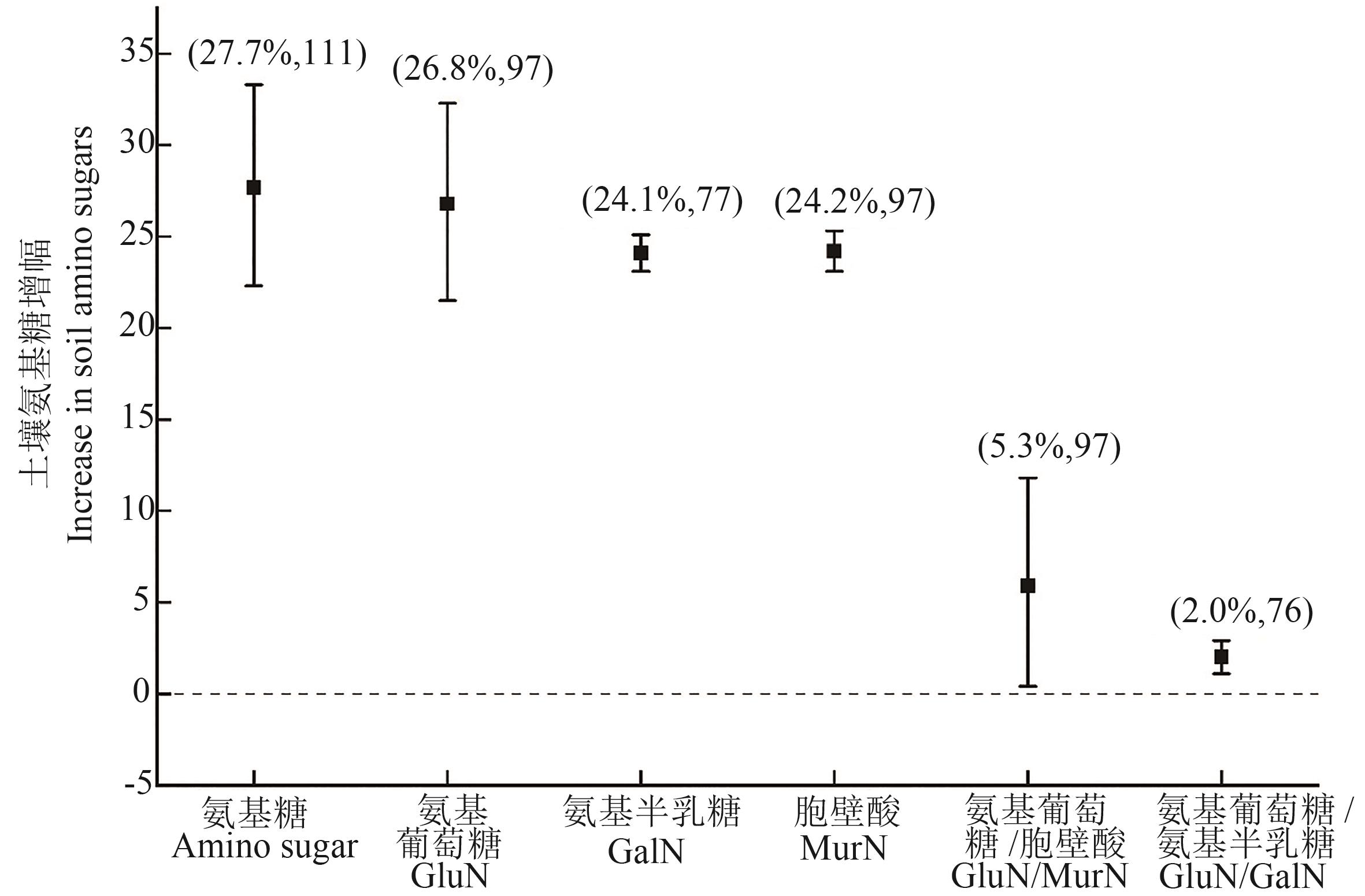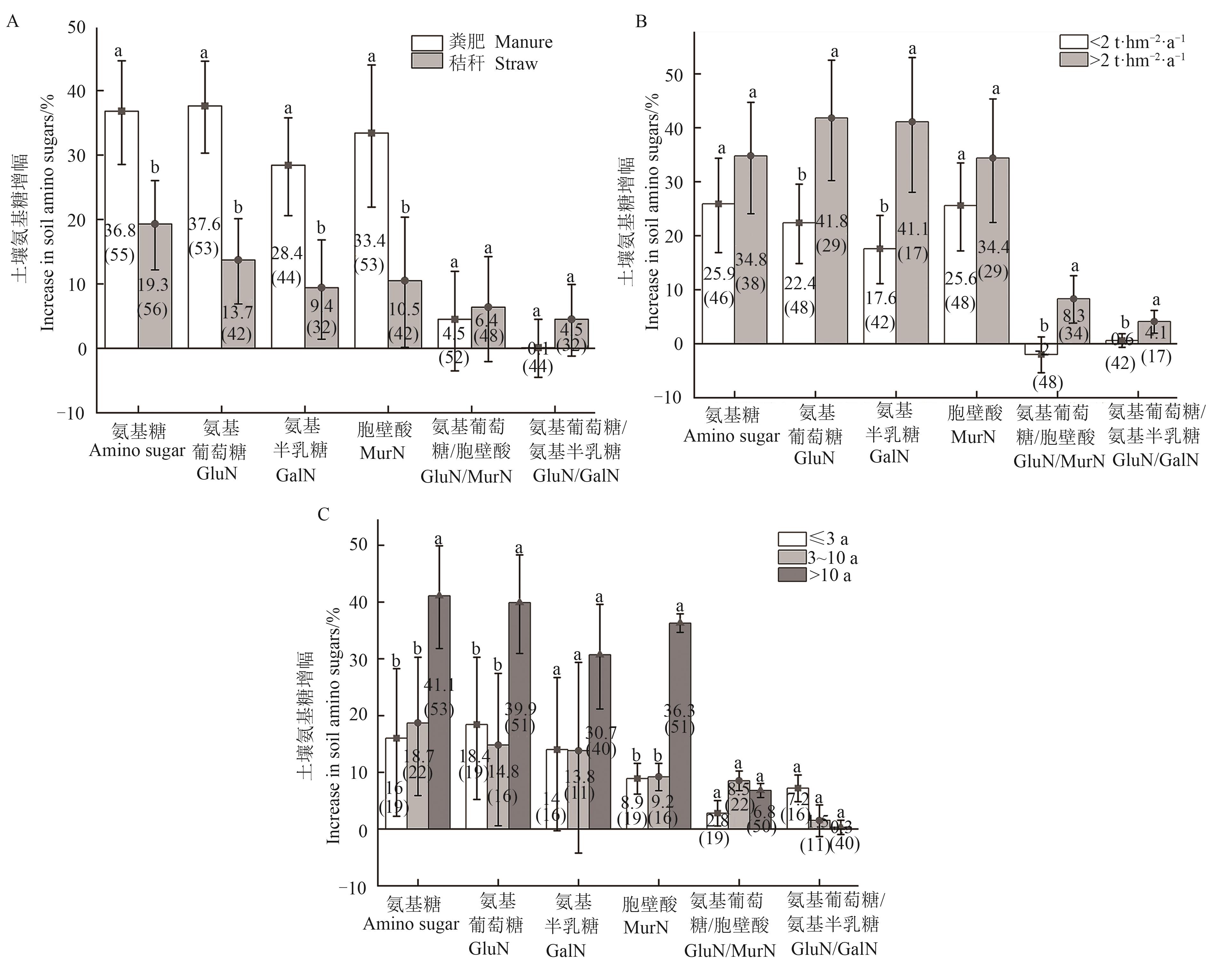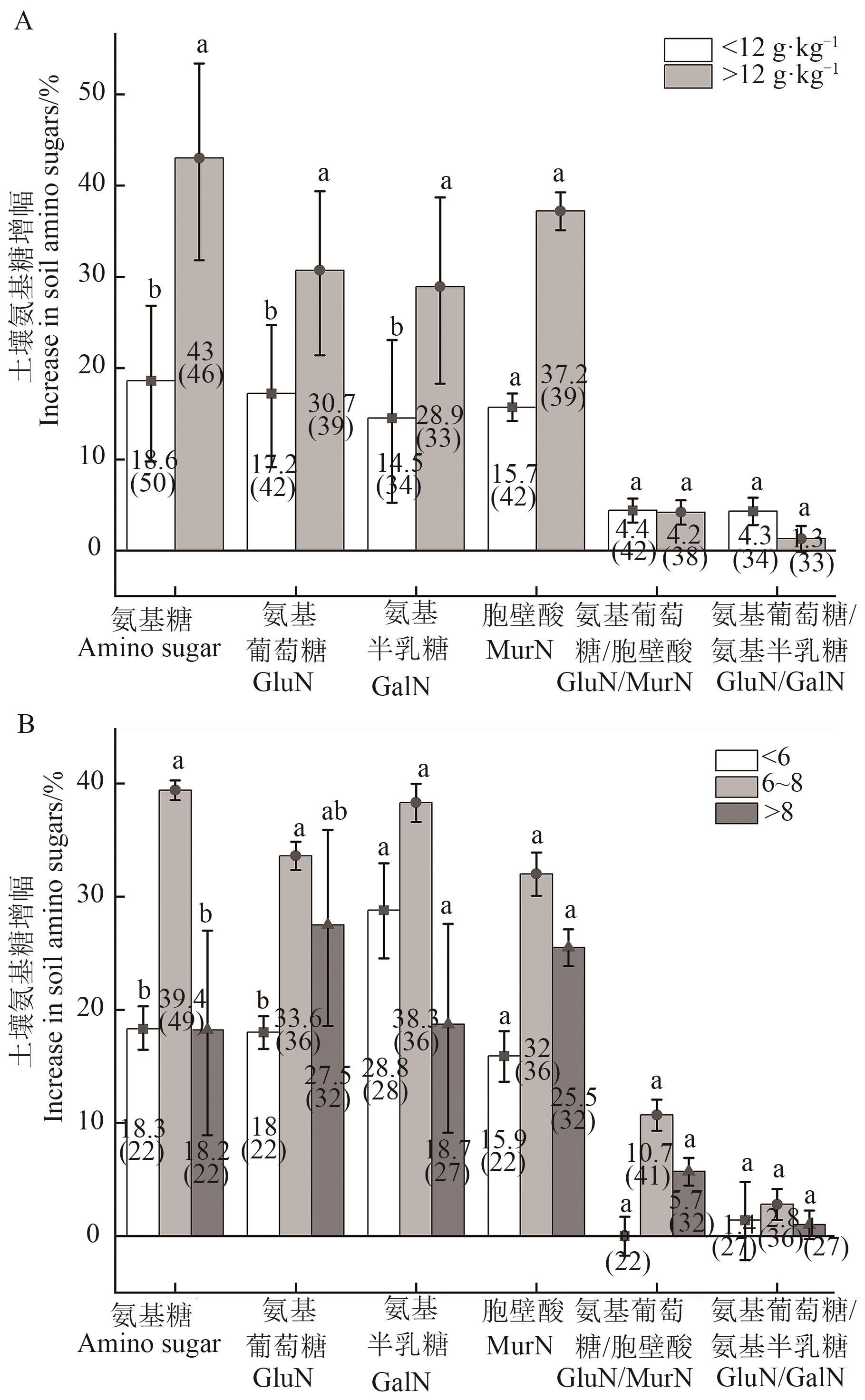




















中国农业科技导报 ›› 2025, Vol. 27 ›› Issue (2): 180-191.DOI: 10.13304/j.nykjdb.2023.0424
• 生物制造 资源生态 • 上一篇
王跃锋1( ), 张晨阳1, 罗正明1(
), 张晨阳1, 罗正明1( ), 李建华1, 李然2, 孙楠2(
), 李建华1, 李然2, 孙楠2( ), 徐明岗1,2
), 徐明岗1,2
收稿日期:2023-06-01
接受日期:2023-10-21
出版日期:2025-02-15
发布日期:2025-02-14
通讯作者:
罗正明,孙楠
作者简介:王跃锋 E-mail:823880562@qq.com
基金资助:
Yuefeng WANG1( ), Chenyang ZHANG1, Zhengming LUO1(
), Chenyang ZHANG1, Zhengming LUO1( ), Jianhua LI1, Ran LI2, Nan SUN2(
), Jianhua LI1, Ran LI2, Nan SUN2( ), Minggang XU1,2
), Minggang XU1,2
Received:2023-06-01
Accepted:2023-10-21
Online:2025-02-15
Published:2025-02-14
Contact:
Zhengming LUO,Nan SUN
摘要:
微生物残体作为有机碳形成的重要前体,对农田土壤中碳的长期固存和稳定至关重要。为探讨有机物料添加对我国农田土壤微生物残体积累的影响,对来自27篇已发表文献的共111组氨基糖(微生物残体表征物质)含量数据进行整合分析,总结添加有机物料对农田土壤氨基糖[氨基葡萄糖(glucosamine,GluN)、氨基半乳糖(galactosamine,GalN)、胞壁酸(muraic acid,MurN)及氨基糖总量]的积累特征,并利用氨基葡萄糖与胞壁酸的比值(GluN/MurN)和氨基葡萄糖与氨基半乳糖(GluN/GalN)的比值探讨真菌和细菌残体对土壤有机质相对贡献的影响。结果表明,添加有机物料显著增加土壤微生物残体的积累,其中土壤氨基糖增幅27.7%,GluN、GalN和MurN 的增幅分别为26.8%、24.1%、24.2%。粪肥对氨基糖和3种单糖的积累显著高于秸秆,增幅为28.4%~37.6%;当有机物料的年均碳投入量高于2 t·hm-2·a-1时,GluN、GalN、GluN/MurN和GluN/GalN显著高于年均碳投入量低于2 t·hm-2·a-1,提高幅度分别为41.8%、41.1%、8.3%和4.1%;当添加有机物料的年限超过10 a时,氨基糖、GluN和MurN的增幅(41.1%、39.9%和36.3%)显著高于试验年限低于10 a。在气候因素中,添加有机物料对氨基糖含量的积累在年均温超过10 ℃(42.0%)和年降水大于800 mm(63.0%)时显著高于年均温小于5 ℃(17.9%)和年降水小于800 mm(28.2%和13.7%)。在土壤因素中,中性(pH 6~8)土壤和肥沃(土壤有机碳含量>12 g·kg-1)土壤的土壤氨基糖总量的积累最高,增幅分别为39.4%和43.0%。回归分析表明,在一定范围内农田土壤微生物残体会随着年降水、年均温、有机物料施用量、有机物料碳投入量和试验年限的增加而增加。综上,添加有机物料,特别是高碳投入量显著增加了农田土壤总氨基糖和氨基单糖的含量。有机物料施用下,温暖湿润地区肥沃中性的土壤有利于促进土壤微生物残体的积累。研究结果为确定添加有机物料对我国农田土壤微生物残体积累的最佳情景、促进稳定土壤有机碳的形成和封存提供了科学依据。
中图分类号:
王跃锋, 张晨阳, 罗正明, 李建华, 李然, 孙楠, 徐明岗. 整合分析添加有机物料对我国农田土壤微生物残体的影响[J]. 中国农业科技导报, 2025, 27(2): 180-191.
Yuefeng WANG, Chenyang ZHANG, Zhengming LUO, Jianhua LI, Ran LI, Nan SUN, Minggang XU. Effect of Adding Organic Materials on Microbial Residues in Farmland in China: A Meta-analysis[J]. Journal of Agricultural Science and Technology, 2025, 27(2): 180-191.

图1 有机物料添加后各氨基糖响应比分布注:M—均值;SD—标准差。
Fig. 1 Distribution of response ratios of various amino sugars after adding organic materialsNote:M—Mean;SD—Standard deviation.

图2 添加有机物料后氨基糖的增幅注:括号内的前数值为增幅,后数值为样本量。
Fig. 2 Increase of amino sugar content after adding organic materialsNote:The first value in parentheses is the increase and the second value is the sample size.

图3 不同有机物料下氨基糖的增幅A:有机物料类型;B:有机物料年均碳投入量;C:有机物料施用年限。柱状图中间的数值为增幅值,括号内的数值为样本量,不同小写字母表示不同处理间在P<0.05水平差异显著
Fig. 3 Increase of amino sugars under different organic material propertiesA:Organic materials type; B: Annual carbon input of organic materials; C: Years of application of organic materials. The middle value of the bar chart represents the increase value, the values in parentheses represent the sample size, and the different lowercase letters indicate significant differences between different treatments at P<0.05 level

图4 不同气候因素下添加有机物料对氨基糖的增幅A:年均温;B:年降水量。柱状图中间的数值为增幅值,括号内的数值为样本量,不同小写字母表示不同处理间在P<0.05水平差异显著
Fig. 4 Increase in amino sugars by addition of organic materials at different climatic factorsA:Average temperature in different years; B: Precipitation in different years. The middle value of the bar chart represents the increase value, the values in parentheses represent the sample size, and the different lowercase letters indicate significant differences between different treatments at P<0.05 level

图5 不同土壤因素下施用有机物料对土壤氨基糖的增幅A:土壤有机碳含量;B:土壤pH。柱状图中间的数值为增幅值,括号内的数值为样本量,不同小写字母表示不同处理间在P<0.05水平差异显著
Fig. 5 Increase in soil amino sugar content by applying organic materials under different soil soil factorsA: Soil organic carbon content; B: Soil pH. The middle value of the bar chart represents the increase value, the values in parentheses represent the sample size, and the different lowercase letters indicate significant differences between different treatments at P<0.05 level

图6 总氨基糖的响应比与年均温、年均降水量、有机物料施用年限和碳投入量、初始土壤性质等的线性关系
Fig. 6 Linear relationships between the response ratio of total amino sugars and annual average temperature, annual precipitation, years of organic material application, carbon input, and initial soil properties
| 1 | 张月鲜. 外源有机物料输入对盐渍化农田温室气体排放和碳固持的影响机制研究[D].呼和浩特: 内蒙古农业大学, 2022. |
| ZHANG Y X. Effects and mechanism of exogenous organic material inputs on greenhouse gas emissions and carbon sequestration in salinized cropland [D]. Hohhot:Inner Mongolia Agricultural University, 2022. | |
| 2 | 林先贵,胡君利.土壤微生物多样性的科学内涵及其生态服务功能[J].土壤学报,2008,45(5):892-900. |
| LIN X G, HU J L. Scientific connotation and ecological service function of soil microbial diversity [J]. Acta Pedol. Sin., 2008,45(5):892-900. | |
| 3 | 梁超,朱雪峰.土壤微生物碳泵储碳机制概论[J].中国科学(地球科学),2021,51(5):680-695. |
| LIANG C, ZHU X F. The soil microbial carbon pump as a new concept for terrestrial carbon sequestration [J]. Sci. Sin. (Terrae), 2021,51(5):680-695. | |
| 4 | 李庭宇,李双异,刘旭,等.土壤微生物标识物——氨基糖的研究进展[J].土壤通报,2022,53(1):241-252. |
| LI T Y, LI S Y, LIU X, et al.. Soil biomarkers—research progress of amino sugars [J]. Chin. J. Soil Sci., 2022,53(1):241-252. | |
| 5 | AMELUNG W. Methods using amino sugars as markers for microbial residues in soil [C]// LAL J M, FOLLETT R F, STEWART B A. Assessment Methods for Soil Carbon. Lewis, USA: Boca Raton, 2001: 233-272. |
| 6 | ENGELKING B, FLESSA H, JOERGENSEN R G. Shifts in amino sugar and ergosterol contents after addition of sucrose and cellulose to soil [J]. Soil Biol. Biochem., 2007,39(8):2111-2118. |
| 7 | DING X L, HAN X Z, ZHANG X D.Long-term impacts of manure,straw,and fertilizer on amino sugars in a silty clay loam soil under temperate conditions [J]. Biol. Fertil. Soils, 2013,49(7):949-954. |
| 8 | YE G P, LIN Y X, KUZYAKOV Y,et al..Manure over crop residues increases soil organic matter but decreases microbial necromass relative contribution in upland ultisols:results of a 27-year field experiment [J].Soil Biol. Biochem., 2019,134:15-24. |
| 9 | CHEN X B, XIA Y H, RUI Y C, et al.. Microbial carbon use efficiency, biomass turnover, and necromass accumulation in paddy soil depending on fertilization [J/OL]. Agric., Ecosyst. Environ., 2020, 292: 106816 [2023-05-06]. . |
| 10 | DING X L, LIANG C, ZHANG B, et al.. Higher rates of manure application lead to greater accumulation of both fungal and bacterial residues in macroaggregates of a clay soil [J]. Soil Biol. Biochem., 2015,84:137-146. |
| 11 | ZENG X M, FENG J, YU D L, et al.. Local temperature increases reduce soil microbial residues and carbon stocks [J]. Glob. Change Biol., 2022,28(21):6433-6445. |
| 12 | HU J X, DU M L, CHEN J, et al.. Microbial necromass under global change and implications for soil organic matter [J]. Globa. Change Biol., 2023,29: 3503-3515. |
| 13 | CHEN G P, MA S H, TIAN D, et al.. Patterns and determinants of soil microbial residues from tropical to boreal forests [J/OL]. Soil Biol. Biochem., 2020, 151: 108059 [2023-05-06]. . |
| 14 | LIU B, ARLOTTI D, HUYGHEBAERT B, et al.. Disentangling the impact of contrasting agricultural management practices on soil microbial communities-importance of rare bacterial community members [J/OL].Soil Biol.Biochem.,2022,166:108573 [2023-05-06]. . |
| 15 | ZHOU R, LIU Y, DUNGAIT J A J, et al.. Microbial necromass in cropland soils:a global meta-analysis of management effects [J].Glob. Change Biol.,2023,29(7):1998-2014. |
| 16 | 张彬,陈奇,丁雪丽,等.微生物残体在土壤中的积累转化过程与稳定机理研究进展[J].土壤学报,2022,59(6):1479-1491. |
| ZHANG B, CHEN Q, DING X L, et al.. Research progress on accumulation,turnover and stabilization of microbial residues in soil [J]. Acta Pedol. Sin., 2022,59(6):1479-1491. | |
| 17 | 王金州,卢昌艾,张金涛,等.RothC模型模拟华北潮土区的土壤有机碳动态[J].中国土壤与肥料,2010(6):16-21, 49. |
| WANG J Z, LU C A, ZHANG J T, et al.. RothC model simulation of soil organic carbon dynamics of fluvo-aquic soil in Northern China [J]. Soil Fert. Sci. China, 2010(6):16-21, 49. | |
| 18 | 韩笑. 农田管理措施对土壤碳库和温室气体排放的影响[D]. 北京:中国农业大学, 2018. |
| HAN X. Effects of agricultural practices on soil carbon stocks and greenhouse gas emissions [D]. Beijing: China Agricultural University, 2018. | |
| 19 | 王雅芝,齐鹏,王晓娇,等.Meta分析中国保护性耕作对土壤微生物多样性的影响[J].草业科学,2021,38(2):378-392. |
| WANG Y Z, QI P, WANG X J,et al..Effect of conservation tillage on soil microbial diversity in China:a Meta-analysis [J]. Pratac. Sci., 2021,38(2):378-392. | |
| 20 | 徐明岗,李然,孙楠,等.施用有机肥煤矿复垦耕地有机碳的固持效率及组分变化[J].植物营养与肥料学报,2022,28(12):2143-2151. |
| XU M G, LI R, SUN N, et al.. Soil organic carbon sequestration efficiency and fractions as affected by organic fertilization rate in reclaimed cultivated land [J]. J. Plant Nutr. Fert., 2022,28(12):2143-2151. | |
| 21 | 全国农业技术推广服务中心.中国有机肥料养分态[M].北京:中国农业出版社,1999:1-200. |
| 22 | HEDGES L V, GUREVITCH J, CURTIS P S. The Meta-analysis of response ratios in experimental ecology [J]. Ecology, 1999, 80(4): 1150-1156. |
| 23 | CURTIS P S, WANG X Z.A meta-analysis of elevated CO2 effects on woody plant mass,form,and physiology [J]. Oecologia, 1998,113(3):299-313. |
| 24 | 李俊娣,张玉铭,赵宝华,等.长期添加外源有机物料对华北平原不同粒级土壤氮素和氨基糖的影响[J].中国生态农业学报,2019,27(4):507-518. |
| LI J D, ZHANG Y M, ZHAO B H, et al.. Effect of long-term addition of organic substances on soil nitrogen and amino sugars in particle-size fractions in the North China Plain [J]. Chin. J. Eco Agric., 2019,27(4):507-518. | |
| 25 | 宁赵,陈香碧,唐海明,等.不同施肥处理下水稻根际和非根际土壤中氨基糖积累特征[J].应用生态学报,2019,30(1):189-197. |
| NING Z, CHEN X B, TANG H M, et al.. Characteristics of amino sugar accumulation in rhizosphere and non-rhizosphere soil of rice under different fertilization treatments [J]. Chin.J. Appl. Ecol., 2019,30(1):189-197. | |
| 26 | 张立恒,刘宝军,程杰,等.干旱地区不同有机物料还田研究进展[J].安徽农业科学,2020,48(19):18-22, 37. |
| ZHANG L H, LIU B J, CHENG J,et al..Research progress on different organic materials returning to field in arid areas [J]. J. Anhui Agric. Sci., 2020,48(19):18-22, 37. | |
| 27 | 汪景宽,徐英德,丁凡,等.植物残体向土壤有机质转化过程及其稳定机制的研究进展[J].土壤学报,2019,56(3):528-540. |
| WANG J K, XU Y D, DING F, et al.. Process of plant residue transforming into soil organic matter and mechanism of its stabilization:a review [J]. Acta Pedol. Sin., 2019,56(3):528-540. | |
| 28 | 薛萍落. 玉米不同残体添加对棕壤团聚体中氨基糖和微生物残体氮的影响[D]. 沈阳: 沈阳农业大学, 2022. |
| XUE P L. Amino sugar and microbial residual nitrogen distribution in aggregates of brown earth affected by different maize residues [D]. Shenyang: Shenyang Agricultural University, 2022. | |
| 29 | XU Y D, GAO X D, LIU Y L,et al..Differential accumulation patterns of microbial necromass induced by maize root vs .shoot residue addition in agricultural Alfisols [J/OL].Soil Biol.Biochem.,2022,164:108474 [2023-05-06].. |
| 30 | 李秀双. 黄土高原南部有机物料还田与化肥施用对冬小麦产量和土壤有机碳固持的影响及机制[D]. 杨凌: 西北农林科技大学, 2021. |
| LI X S. Effects and mechanisms of organic amendments and mineral fertilization on winter wheat yield and soil organic carbon sequestration in the Southern Loess Plateau [D]. Yangling: Northwest A&F University, 2021. | |
| 31 | 付桃桃. 地膜覆盖和秸秆还田对农田土壤碳水化合物的影响[D].兰州: 兰州大学,2016. |
| FU T T. Effects of straw incorporation and plastic film mulch on soil carbohydrates [D]. Lanzhou: Lanzhou University, 2016. | |
| 32 | 赵搏. 长期地膜覆盖和施肥条件下棕壤氨基糖积累特征研究[D]. 沈阳: 沈阳农业大学, 2020. |
| ZHAO B. Accumulation of amino sugars in brown earth under long-term mulching and fertilization [D]. Shenyang: Shenyang Agricultural University, 2020. | |
| 33 | WANG Y J, LIU L, LUO Y,et al..Mulching practices alter the bacterial-fungal community and network in favor of soil quality in a semiarid orchard system [J/OL]. Sci. Total Environ., 2020,725:138527 [2023-05-06]. . |
| 34 | ZHAO J, NI T, LI J, et al.. Effects of organic-inorganic compound fertilizer with reduced chemical fertilizer application on crop yields,soil biological activity and bacterial community structure in a rice-wheat cropping system [J]. Appl. Soil Ecol., 2016,99:1-12. |
| 35 | XIA Y H, CHEN X B, ZHENG S M, et al.. Manure application accumulates more nitrogen in paddy soils than rice straw but less from fungal necromass [J/OL]. Agric. Ecosyst. Environ., 2021, 319: 107575 [2023-05-06]. . |
| 36 | 梁尧,韩晓增,宋春,等.不同有机物料还田对东北黑土活性有机碳的影响[J].中国农业科学,2011,44(17):3565-3574. |
| LIANG Y, HAN X Z, SONG C,et al..Impacts of returning organic materials on soil labile organic carbon fractions redistribution of mollisol in Northeast China [J]. Sci. Agric. Sin., 2011,44(17):3565-3574. | |
| 37 | AHMED A A Q, ODELADE K A, BABALOLA O O. Microbial inoculants for improving carbon sequestration in agroecosystems to mitigate climate change [C]// Handbook of Climate Change Resilience. Springer, 2019: 381-401. |
| 38 | MVLLER K, MARHAN S, KANDELER E, et al.. Carbon flow from litter through soil microorganisms: from incorporation rates to mean residence times in bacteria and fungi [J]. Soil Biol. Biochem., 2017, 115: 187-196. |
| 39 | CROWTHER T W, THOMAS S M, MAYNARD D S, et al.. Biotic interactions mediate soil microbial feedbacks to climate change [J].Proc. Natl. Acad. Sci. USA,2015,112(22):7033-7038. |
| 40 | 李秀英,赵秉强,李絮花,等.不同施肥制度对土壤微生物的影响及其与土壤肥力的关系[J].中国农业科学,2005,38(8):1591-1599. |
| LI X Y, ZHAO B Q, LI X H, et al.. Effects of different fertilization systems on soil microbe and its relation to soil fertility [J]. Sci. Agric. Sin., 2005,38(8):1591-1599. | |
| 41 | 姜文婷,高翔菲,宋锦浩,等.不同土地利用方式土壤有机碳组分及微生物群落对植物残体输入的响应[J].土壤通报,2023,54(4):831-839. |
| JIANG W T, GAO X F, SONG J H,et al..Responses of organic carbon fractions and microbial communities to plant residues under different land use patterns [J]. Chin. J. Soil Sci., 2023,54(4):831-839. | |
| 42 | MA L X, JU Z Q, FANG Y Y, et al.. Soil warming and nitrogen addition facilitates lignin and microbial residues accrual in temperate agroecosystems [J/OL]. Soil Biol. Biochem., 2022, 170: 108693 [2023-05-06]. . |
| 43 | ZHONG F, WU J, DAI Y R,et al..Bacterial community analysis by PCR-DGGE and 454-pyrosequencing of horizontal subsurface flow constructed wetlands with front aeration [J]. Appl. Microbiol. Biotechnol., 2015,99(3):1499-1512. |
| 44 | 崔勇兴. 土壤微生物养分限制特征及驱动机制研究[D]. 咸阳: 中国科学院大学(中国科学院教育部水土保持与生态环境研究中心), 2020. |
| CUI Y X. Study on the characteristics and driving mechanisms of soil microbial nutrient limitation [D]. Xianyang: University of Chinese Academy of Sciences (Water and Soil Conservation and Ecological Environment Research Center of the Ministry of Education, Chinese Academy of Sciences), 2020. | |
| 45 | DOMEIGNOZ-HORTA L A, POLD G, LIU X J A,et al..Microbial diversity drives carbon use efficiency in a model soil [J/OL].Nat.Commun.,2020,11:3684 [2023-05-06]. . |
| 46 | ROUSK J, BROOKES P C, BÅÅTH E.Contrasting soil pH effects on fungal and bacterial growth suggest functional redundancy in carbon mineralization [J].Appl. Environ. Microbial., 2009,75(6):1589-1596. |
| 47 | NI X Y, LIAO S, TAN S Y, et al.. A quantitative assessment of amino sugars in soil profiles [J/OL].Soil Biol. Biochem.,2020,143:107762 [2023-05-06]. . |
| 48 | MANZONI S, TAYLOR P, RICHTER A, et al.. Environmental and stoichiometric controls on microbial carbon-use efficiency in soils [J]. New Phytol., 2012,196(1):79-91. |
| 49 | LIANG C, SCHIMEL J P, JASTROW J D. The importance of anabolism in microbial control over soil carbon storage [J/OL].Nat. Microbial.,2017,2:17105 [2023-05-06].. |
| 50 | 杨阳,窦艳星,王宝荣,等.黄土高原土壤有机碳固存机制研究进展[J].第四纪研究,2023,43(2):509-522. |
| YANG Y, DOU Y X, WANG B R,et al..Advances in soil organic carbon sequestration mechanisms on the Chinese Loess Plateau [J]. Quat. Sci., 2023,43(2):509-522. |
| [1] | 于远介, 张青青, 马建国, 江康威, 李宏. 不同植物群落土壤有机碳及其组分的差异[J]. 中国农业科技导报, 2024, 26(9): 173-182. |
| [2] | 梁永进, 朱睿璇, 韦贝蕾, 袁小迈, 成武洋, 彭博, 王梓廷, 韦建玉. 有机肥配施对我国烟叶品质影响的整合分析[J]. 中国农业科技导报, 2024, 26(12): 164-175. |
| [3] | 高静, 徐明岗, 李然, 蔡泽江, 孙楠, 张强, 郑磊. 整合分析生物炭施用对土壤pH的影响[J]. 中国农业科技导报, 2023, 25(9): 186-196. |
| [4] | 张晨阳, 徐明岗, 王斐, 李然, 孙楠. 施用有机肥对我国大豆产量及土壤养分的影响[J]. 中国农业科技导报, 2023, 25(8): 148-156. |
| [5] | 董林林, 查金芳, 沈明星, 王海候, 施林林, 陶玥玥, 周新伟, 陆长婴. 长期秸秆还田对稻麦轮作区土壤有机碳组分构成的影响[J]. 中国农业科技导报, 2022, 24(3): 166-175. |
| [6] | 刘慧霞, 孙宗玖, 石宇堃, 武文超, 郑丽, 艾提剑. 准噶尔盆地梭梭沙质荒漠土壤有机碳分布特征的研究[J]. 中国农业科技导报, 2021, 23(11): 147-155. |
| [7] | 李龙1,秦富仓1*,姜丽娜2,姚雪玲3. 半干旱区土壤有机碳时空变异特征研究[J]. 中国农业科技导报, 2020, 22(3): 100-107. |
| [8] | 王进,刘子琦*,张国,李渊,鲍恩俣. 石漠化区林草恢复与传统农耕对土壤团聚体和有机碳含量的影响[J]. 中国农业科技导报, 2020, 22(11): 133-143. |
| [9] | 张丹凤1,陈国平2,张国广1,黄家福1,华秀婷1,陈阳1 . AmrB对嗜水气单胞菌氨基糖苷类抗生素耐药性的影响[J]. , 2013, 15(3): 123-128. |
| [10] | 陈卓,史锟. 两个丘陵山地粘棕壤土壤剖面不同土层有机碳与比重的关系[J]. , 2008, 10(2): 119-122. |
| 阅读次数 | ||||||
|
全文 |
|
|||||
|
摘要 |
|
|||||
 京公网安备11010802021197号
京公网安备11010802021197号